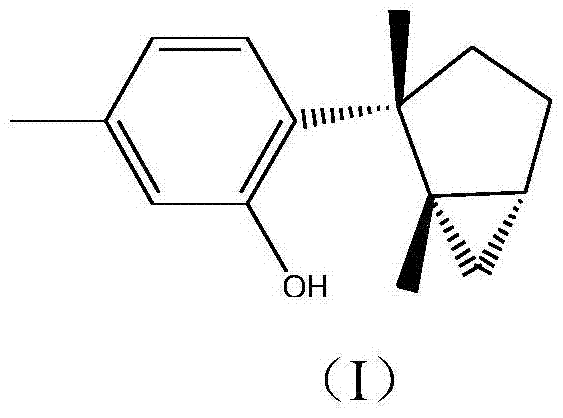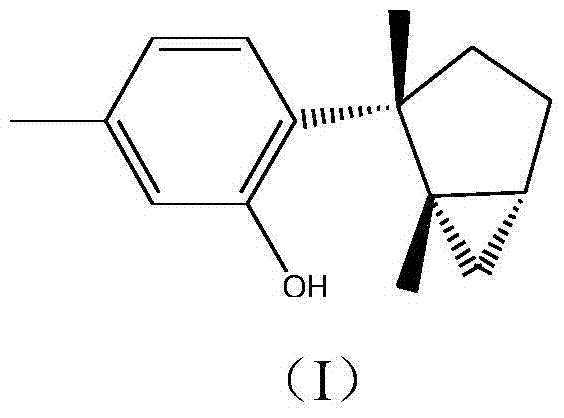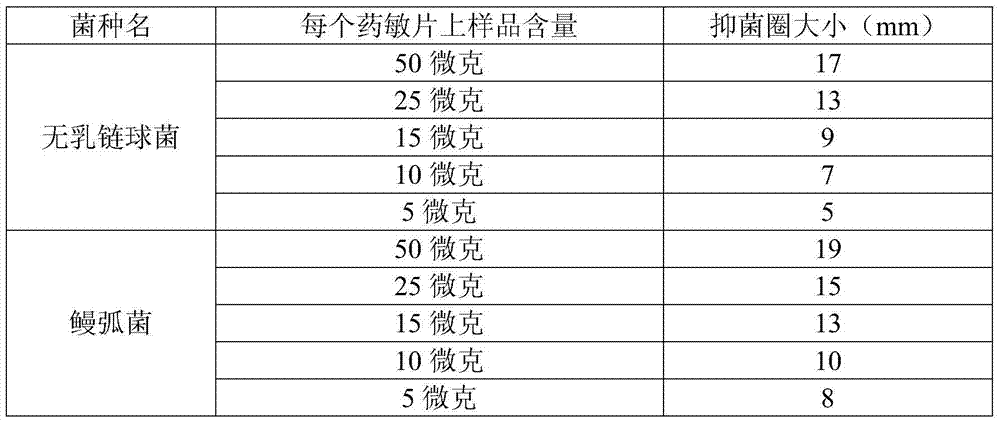Application of a kind of seaweed sesquiterpene compound
A technology for sesquiterpenoids and compounds is applied in the application field of seaweed sesquiterpenoids, which can solve the problems of bacterial drug resistance, ecological environment destruction and the like, and achieve significant bacteriostatic activity, wide application prospects, and easy preparation. Effect
- Summary
- Abstract
- Description
- Claims
- Application Information
AI Technical Summary
Problems solved by technology
Method used
Image
Examples
Embodiment 1
[0018] The preparation method of embodiment 1 seaweed sesquiterpenoids (1)
[0019] (1) Collect fresh Laurencia okamurai, wash with seawater, remove sand and algae attached to the surface, dry in the shade, and then pulverize. Soak and extract with methanol-dichloromethane (volume ratio 3:1), combine the extracts and concentrate to obtain a crude extract; extract the crude extract three times with ethyl acetate and concentrate under reduced pressure at a temperature of 40°C to obtain the crude extract after extraction. Extract 16.0g.
[0020] (2) The crude extract was subjected to 200-300 mesh silica gel column chromatography, and petroleum ether-ethyl acetate was used at 100:0, 50:1, 20:1, 10:1, 5:1, 2:1 to 0 :100 gradient for elution, collect the eluate respectively, and then detect with thin layer chromatography (TLC) (vanillin-sulfuric acid color development), judge according to the Rf value, merge the same or similar parts, and obtain 14 groups points (1-14). Fraction ...
Embodiment 2
[0024] The preparation method of embodiment 2 seaweed sesquiterpenoids (2)
[0025] (1) Collect fresh Laurencia okamurai, wash with seawater, remove sand and algae attached to the surface, dry in the shade, and then pulverize.
[0026] Soak and extract with 95% ethanol, combine the extracts and concentrate to obtain a crude extract; extract the crude extract three times with ethyl acetate and concentrate under reduced pressure at a temperature of 40°C to obtain 11.8 g of the extracted crude extract.
[0027] (2) The crude extract was subjected to 200-300 mesh silica gel column chromatography, using petroleum ether-ethyl acetate with a gradient of 50:1, 20:1, 10:1, 5:1, 2:1, 1:1 Carry out elution, collect eluate separately, detect (vanillin-sulfuric acid color development) with thin-layer chromatography (TLC) again, judge according to Rf value, merge identical or similar part, obtain 10 components (1~ 10). Component 2, that is, the component eluted with petroleum ether-ethyl ...
Embodiment 3
[0030] Embodiment 3 antibacterial activity experiment
[0031] The bacterial culture medium used in the experiment was NB nutrient broth medium, and the bacterial suspension was soaked with a sterile cotton swab, and spread evenly on the M-H medium. The seven strains used were Streptococcus agalactiae, Vibrio anguillarum, Aeromonas hydrophila, Vibrio taburi, Streptococcus iniae, Edwardsiella and HN016.
[0032] The test samples of the compound prepared in Example 1 were dissolved in methanol at concentrations of 5.0, 2.5, 1.5, 1 and 0.5 mg / ml, respectively. Take 10 microliters of sample solution and add it to a sterile filter paper sheet with a diameter of 5 mm (50, 25, 15, 10 and 5 micrograms per sheet), test the antibacterial effect under different gradients; and add the same volume of methanol and The dried filter paper was used as a negative control, and erythromycin, amikacin, chloramphenicol, cotrimoxazole and gentamicin were used as antibacterial positive controls, eac...
PUM
 Login to View More
Login to View More Abstract
Description
Claims
Application Information
 Login to View More
Login to View More - R&D
- Intellectual Property
- Life Sciences
- Materials
- Tech Scout
- Unparalleled Data Quality
- Higher Quality Content
- 60% Fewer Hallucinations
Browse by: Latest US Patents, China's latest patents, Technical Efficacy Thesaurus, Application Domain, Technology Topic, Popular Technical Reports.
© 2025 PatSnap. All rights reserved.Legal|Privacy policy|Modern Slavery Act Transparency Statement|Sitemap|About US| Contact US: help@patsnap.com



